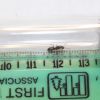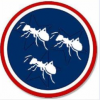Hello,
ID help please.
1. Location (on a map) of collection: Kent County, Delaware
2. Date of collection: 4-4-2021
3. Habitat of collection: in my yard
4. Length (from head to gaster): about 7mm
5. Color, hue, pattern and texture: see pics
6. Distinguishing characteristics: n/a
7. Distinguishing behavior: n/a
8. Nest description: n/a
9. Nuptial flight time and date: n/a
















